Author: James Butterfill
_Translation: __Aki, _Wu Says Blockchain
Gold and Bitcoin are often compared as scarce, non-sovereign assets. While there has been extensive discussion about their investment cases as stores of value, there has been little comparison at the production level. Both assets rely on mining—one physical, the other digital—to introduce new supply. The industrial characteristics of both are defined by cyclical economies, capital intensity, and deep connections to energy markets.
However, the mechanisms and incentives of Bitcoin mining differ subtly from those of gold mining, and these differences ultimately have significant implications for the economic structure and strategic positioning of industry participants. This report will take you through some of their similarities, but more importantly, the substantial differences between them.
Asset Scarcity Arises from Physical and Computational Mining
Gold mining is a centuries-old process involving the extraction and refinement of metal from underground, requiring the identification of suitable deposits, obtaining permits and land use rights, and using heavy machinery to extract ore from the ground, followed by chemical processing to separate the metal for subsequent distribution.
In contrast, Bitcoin mining requires repeated computational processes to solve batches of Bitcoin transactions in a competitive manner, earning newly issued Bitcoins and transaction fees. This process is known as Proof of Work, which necessitates the procurement of rack space, electricity, and specialized hardware (ASICs) to operate computations efficiently, and then broadcasting the results to the Bitcoin network via an internet connection.
In both systems, mining is an inevitably high-cost process that underpins the scarcity of each asset: Bitcoin's scarcity is maintained by code and competition; gold's scarcity is determined by physical and geological location. However, the methods of extracting scarcity, the economic models of producers, and their evolution over time have almost no similarities.
Bitcoin Mining Economic Model: Competition, Technological Advancement, and Diverse Revenue Streams
The economic model of gold mining is relatively predictable. Companies can usually forecast reserves, ore grades, and mining schedules with reasonable accuracy, although initial forecasts may vary significantly: about one-fifth of gold mining projects achieve profitability over their lifetimes. Major costs—labor, energy, equipment, compliance, and remediation—can be predicted with reasonable accuracy in advance. Depreciation mainly arises from normal wear and tear of equipment or depletion of reserves. The primary short- to medium-term uncertainty typically lies in the stability of gold market prices, which exhibit relatively low volatility. Furthermore, almost all of these input costs can be effectively hedged.
In contrast, Bitcoin mining is more dynamic and unpredictable. Company revenues depend not only on the relative fluctuations of Bitcoin market prices but also on their share of the global hash rate (i.e., global competition). If other miners aggressively expand their operations, even if your mining operation remains unchanged, your relative output may decline. This is a variable that miners must continuously consider during operations.
Thus, our first distinction is that, unlike the relatively stable production forecasts of gold mining, Bitcoin miners face the challenge of production uncertainty, which arises from the entry and exit of other industry participants and their strategic changes.
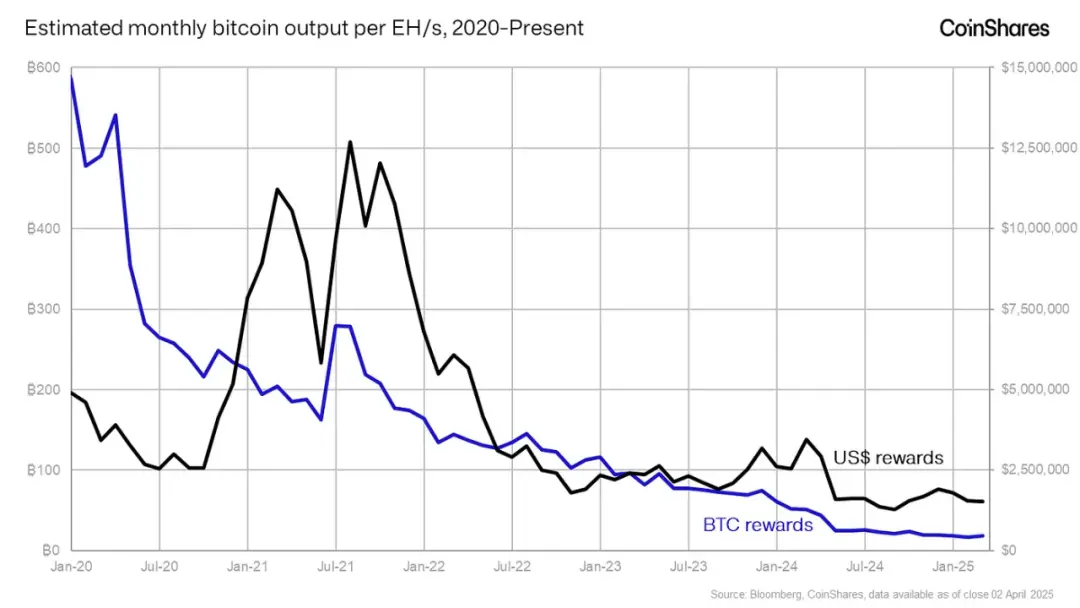
One of the most significant costs for Bitcoin mining companies is depreciation, particularly of ASIC equipment. The chips in these Bitcoin miners are rapidly improving in efficiency, forcing companies to upgrade their equipment before natural wear occurs to remain competitive. This means that depreciation occurs on the timeline of technological advancement rather than physical wear of the equipment. This is a major expense—albeit a non-cash expense—and stands in stark contrast to gold mining, where mining equipment has a longer lifespan as it has already undergone most efficiency improvements.
Bitcoin production, influenced by changes in industry competition and the shared impact of short-term depreciation cycles, leads miners to face constant pressure to reinvest in new hardware to maintain production levels—what professionals often refer to as the "ASIC hamster wheel."
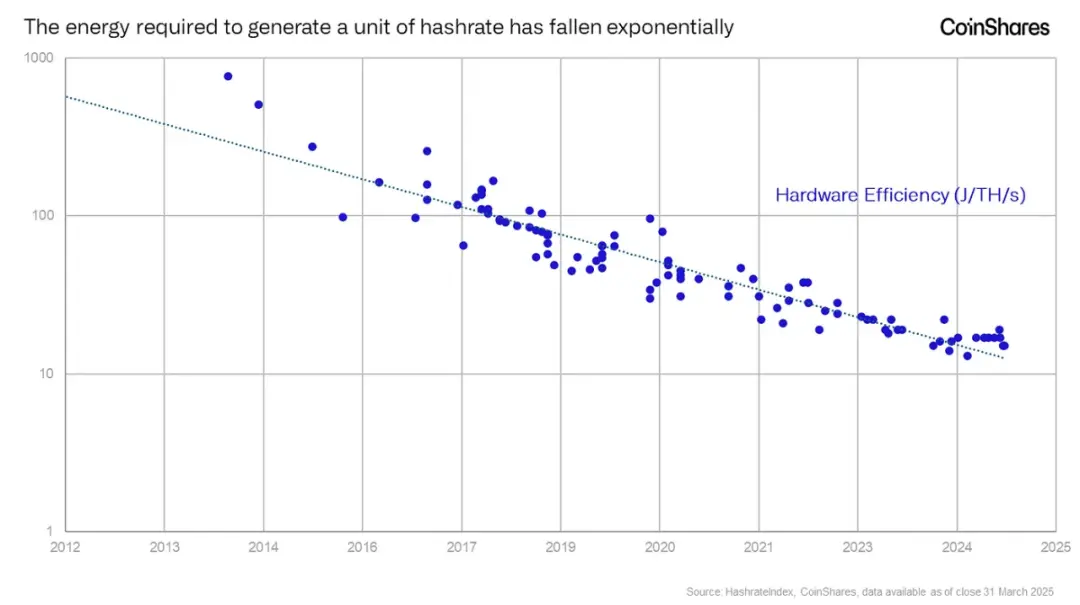
However, there is also a favorable fundamental difference between Bitcoin and gold regarding revenue structure. Gold miners profit solely from extracting and selling unreleased supplies from reserves. In contrast, Bitcoin miners profit both from extracting unreleased supplies and from transaction fees. Transaction fees provide miners with a revenue source from released supplies, which fluctuates based on the demand for Bitcoin transfers. As Bitcoin approaches its supply cap of 21 million, transaction fees will become an increasingly important revenue source—something that gold miners do not experience.
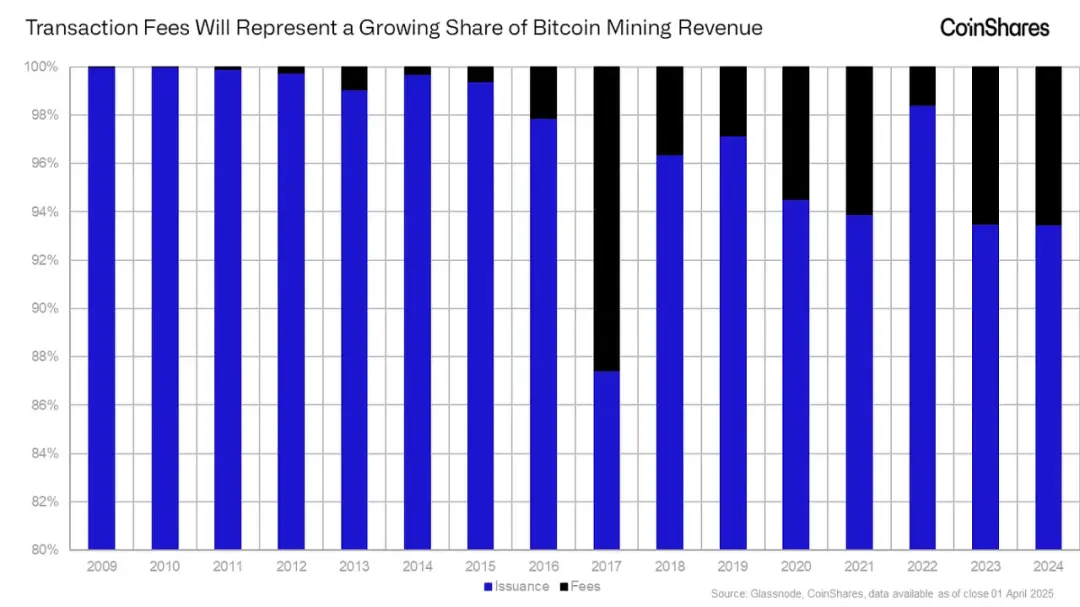
Note: The y-axis shows a bottom range of 80%.
Finally, a major long-term advantage of Bitcoin mining is the ability to repurpose byproducts generated during operations—heat. When electricity passes through mining machines, it generates significant heat, which can be captured and redirected for other uses, such as industrial processes, greenhouse agriculture, or residential and district heating. This opens up new revenue streams for miners. As mining machines become commoditized and depreciation cycles extend, the impact of heat repurposing may further increase. Similarly, gold miners can benefit from selling byproducts like silver or zinc, which are typically identified during project planning and serve as elements to offset gold production costs.
Bitcoin Mining Has a Brighter Environmental Future than Gold Mining
It is well known that gold mining is inherently resource-extractive and leaves a lasting physical footprint: deforestation, water pollution, waste ponds, and ecosystem destruction. In many areas, it also raises concerns about land rights and worker safety.
On the other hand, Bitcoin mining does not involve physical extraction but relies entirely on electricity. This provides opportunities for integration with local infrastructure—rather than conflict. Because miners are mobile and can be interrupted, they can act as stabilizers for the grid and monetize energy resources that would otherwise be wasted or isolated (such as flared gas, excess hydropower, or constrained wind and solar energy).
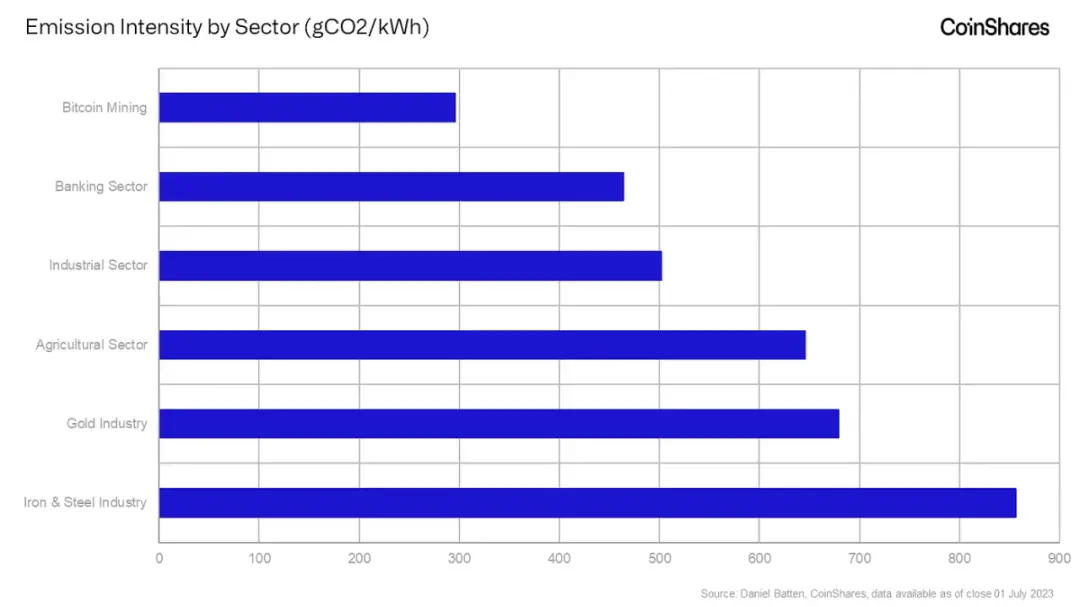
Many people may not realize that Bitcoin mining also shows potential as a clean energy subsidy and can serve as a means of proving grid connectivity. By co-locating with renewable energy or nuclear power facilities, miners can improve the economics of projects before grid connection—without relying on public funding subsidies.
Finally, although this has been well documented, it is worth noting that Bitcoin has lower and more transparent carbon emissions on average compared to traditional industries. It can be argued that Bitcoin is even necessary for a smooth transition to a renewable energy-dominated grid.
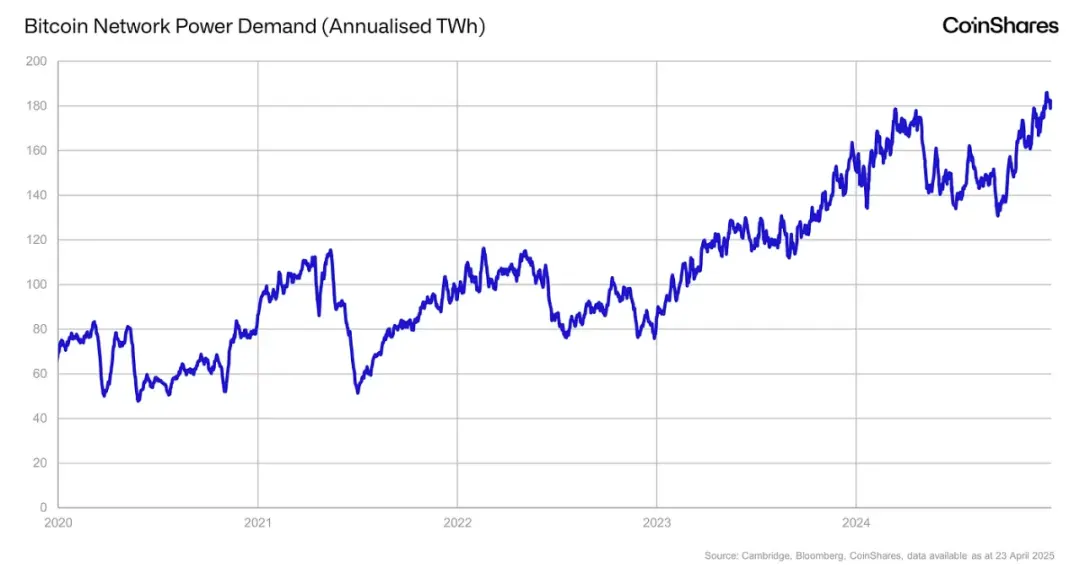
Since the peak of energy consumption in 2024, we have seen almost no increase in energy consumption, attributed to the continuous improvement in the efficiency of new mining hardware, with the current average power consumption at just 20 watts per terahash (W/Th), a fivefold increase in efficiency compared to 2018.
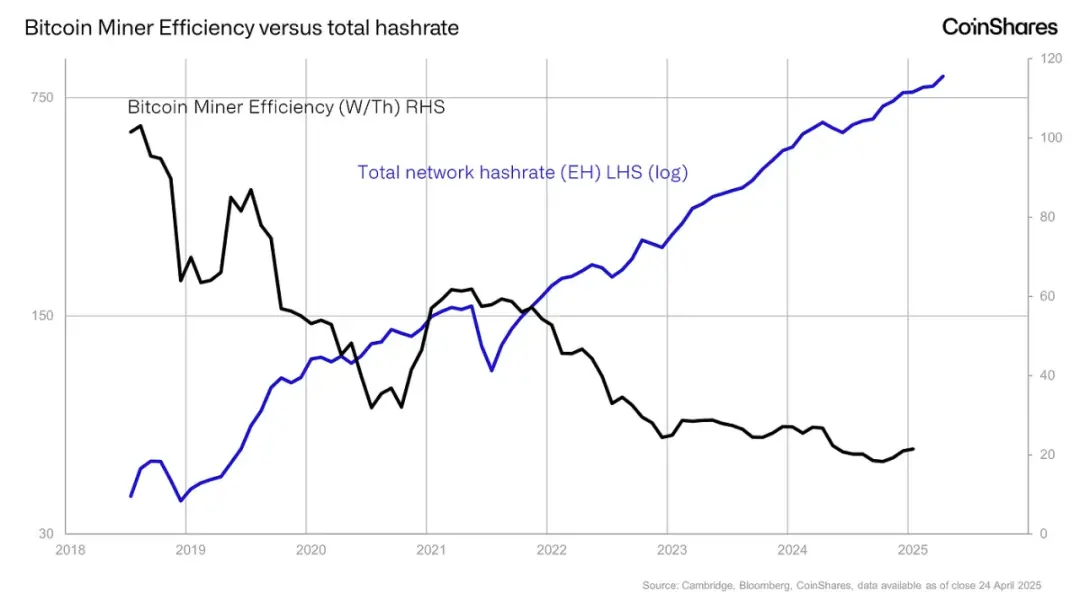
Investment Characteristics of Bitcoin Mining: Rapid Cycles and Technology-Driven
Both industries are cyclical and sensitive to the prices of their production assets. However, unlike gold miners, who typically operate on multi-year timelines, Bitcoin miners can scale their operations up or down more quickly based on market conditions. This makes Bitcoin mining more flexible but also more volatile.
Publicly traded Bitcoin mining companies often trade like high-beta tech stocks, reflecting their sensitivity to Bitcoin prices and broader risk sentiment. In fact, some market data providers classify publicly listed Bitcoin miners as part of the tech sector rather than traditional energy or materials sectors.
However, gold mining companies have a longer history and typically hedge future production, which can reduce sensitivity to fluctuations in gold prices. They are usually classified as part of the materials sector and are evaluated like traditional commodity producers.
The methods of capital formation also differ. Gold miners typically raise capital based on reserve estimates and long-term mine plans. In contrast, Bitcoin miners tend to be more opportunistic, often raising funds through direct or convertible equity offerings in recent years to support rapid hardware upgrades or data center expansions. As a result, Bitcoin miners are more reliant on market sentiment and cyclical timing, often operating within shorter reinvestment cycles.
Bitcoin Mining: Investment Opportunities in Energy, Computing, and Future Financial Networks
Gold and Bitcoin may trend toward playing similar macroeconomic roles in the long run, but their production ecosystems are structurally different. Gold mining develops slowly, is resource-extractive, and has harmful environmental impacts with high resource consumption. Bitcoin mining, on the other hand, is faster, modular, and may increasingly integrate with modern energy systems.
For investors, this means that Bitcoin miners are not a perfect digital analog to gold miners. Instead, they represent a new class of capital-intensive infrastructure that merges investment opportunities in commodity cycles, energy markets, and technological disruption. Investors with a long-term perspective should view them as a unique, new asset class with distinct fundamentals, especially in the context of increasingly important transaction fees and evolving energy partnerships.
In our view, understanding these nuances is essential for making informed investment decisions in an environment increasingly moving toward a distributed financial system.
As an investment, Bitcoin miners not only provide an opportunity to invest in scarcity but also involve investment opportunities in data center infrastructure, growth in energy markets, and the monetization of computing power—an integration that traditional mining cannot achieve.
Prospects for Bitcoin Mining Development
Overall, we believe that most potential macroeconomic scenarios post-"liberation day" remain favorable for Bitcoin. The introduction of reciprocal tariffs may drive the U.S. and its trading partners to push inflation higher. U.S. trading partners may face rising inflation while contending with growth headwinds. This dynamic could force them to adopt more accommodative fiscal and monetary policies—measures that typically lead to currency depreciation, thereby enhancing Bitcoin's appeal as a non-sovereign, anti-inflation asset.
In the United States, the outlook is more ambiguous. Both Trump and Besant have expressed a preference for lower long-term yields, particularly regarding the 10-year Treasury bonds. While the motivations behind this can be speculated—such as reducing the debt service burden or stimulating asset markets—this stance typically benefits interest rate-sensitive assets like Bitcoin. However, the current situation is quite the opposite. The yield on the U.S. 10-year Treasury bond has fallen below 4% but then rebounded to 4.5%, currently around 4.3%, due to skepticism about the underlying trades being closed, damage to the U.S. reputation, and the increasingly precarious status of the dollar as the global reserve currency, while Trump's uncompromising tariff policies may further drive inflation upward. However, this crisis is man-made and can be quickly reversed through tariff concessions and agreements.
Nonetheless, these signals may also reflect a decline in future earnings expectations for the stock market, raising concerns about an impending economic slowdown. This poses a key risk for the broader market, including Bitcoin. If investors continue to view Bitcoin as a high-beta, risk-on asset, this sentiment may lead to Bitcoin trading in sync with the stock market during a global economic downturn, despite its narrative as a long-term store of value still existing.
Nevertheless, Bitcoin has performed relatively well compared to the stock market since "Liberation Day." This resilience highlights Bitcoin's unique characteristics: it is a globally tradable, government-neutral asset with a fixed supply, accessible 24/7 year-round. As a result, market participants are increasingly recognizing Bitcoin as a reliable long-term store of value.
免责声明:本文章仅代表作者个人观点,不代表本平台的立场和观点。本文章仅供信息分享,不构成对任何人的任何投资建议。用户与作者之间的任何争议,与本平台无关。如网页中刊载的文章或图片涉及侵权,请提供相关的权利证明和身份证明发送邮件到support@aicoin.com,本平台相关工作人员将会进行核查。




